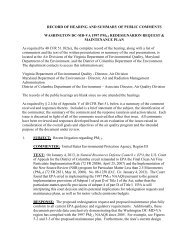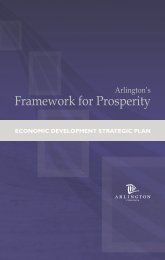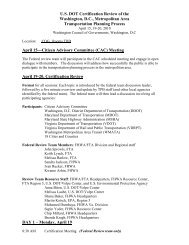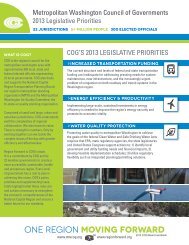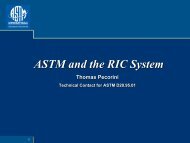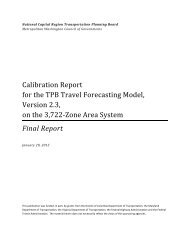PTI Local Government Energy Assurance Guidelines - Metropolitan ...
PTI Local Government Energy Assurance Guidelines - Metropolitan ...
PTI Local Government Energy Assurance Guidelines - Metropolitan ...
You also want an ePaper? Increase the reach of your titles
YUMPU automatically turns print PDFs into web optimized ePapers that Google loves.
<strong>Energy</strong> Efficiency<br />
Efficient energy use, sometimes simply called energy efficiency, is using less energy to meet the same need. <strong>Energy</strong><br />
efficiency is often referred to as the “first fuel” supply to tap when looking for new generation sources, since it is the<br />
most cost-effective choice. <strong>Energy</strong> efficiency applications are relatively easy to understand. For example, insulating<br />
a home allows a building to use less heating and cooling energy to achieve and maintain a comfortable temperature.<br />
Many efficiency technologies, including light emitting diodes (LEDs), compact fluorescent lighting (CFLs), and<br />
efficient heating, ventilation, and air conditioning (HVAC) systems—as well as the use of design elements such<br />
as day-lighting, passive solar heating, and natural ventilation—reduce the amount of electricity needed to operate<br />
facilities in all situations. In an emergency, efficient facilities require less backup power.<br />
Lighting generally forms a significant part of a local government’s electricity budget, and the exciting and increasing<br />
number of applications for LED lighting provide a way for major gains in efficiency. The efficacy (lumen/watt) of<br />
currently available LED lighting ranges from about 25-45 lm/Watt, with efficacies of 50-100 already demonstrated.<br />
In contrast, incandescent lighting is about 10-12 lm/Watt. LEDs, therefore, can reduce lighting expenses to one-half<br />
or even one-quarter of the costs for incandescent lighting and one-tenth the cost is on the horizon.<br />
In addition to energy efficiency, LED technology delivers longer lamp life than incandescent (25,000 hours rather<br />
than 1,000 hours); lower heat output (reducing cooling loads) and improved durability. Applications of LED lighting<br />
include traffic signals (one of the earliest uses), exit signs, accent lights, signage, outdoor lighting, residential task<br />
and spot lighting, and store display cases—and the list is steadily increasing.<br />
Certain LED lighting fixtures for the residential sector are ENERGY STAR® certified, and include under cabinet<br />
lighting, desk task lights and outdoor pathway lights. Details on the specific lighting types and their performances<br />
are listed on the ENERGY STAR website, www.energystar.gov/purchasing. Using this technology in the residential,<br />
commercial and industrial sectors can lead to major energy efficiency improvements.<br />
<strong>Energy</strong>-efficient technologies enjoy significant market share in many areas. For example, the sales of ENERGY<br />
STAR-certified CFLs are doubling each year, according to estimates by the U.S. Environmental Protection Agency<br />
(EPA). Many communities purchase and/or sell CFLs along with their local utility in formal campaigns to raise<br />
energy efficiency awareness. CFLs generally use around 1/3 the electricity of traditional incandescent bulbs while<br />
lasting eight to ten times as long. Lighting can account for 60 percent of the energy consumed in commercial<br />
buildings; much of this energy is used to cool spaces heated through the use of inefficient lighting.<br />
<strong>Energy</strong> efficiency investments should be considered a cost-effective complement to investments in other more<br />
traditional energy supplies. In addition to reducing the cost of day-to-day operations, energy efficiency programs can<br />
prove effective in reducing peak electricity demand, lowering consumption when the power grid is most stressed, and<br />
thereby reducing the likelihood of an outage. 12<br />
12<br />
American Council for an <strong>Energy</strong>-Efficient Economy, Examining the Peak Demand Impacts of <strong>Energy</strong> Efficiency: A Review of Program<br />
Experience and Industry Practices, February 2007.<br />
<strong>Local</strong> <strong>Government</strong> <strong>Energy</strong> <strong>Assurance</strong> <strong>Guidelines</strong> – Version 2.0 | 21



